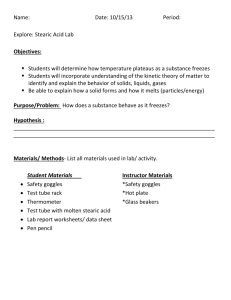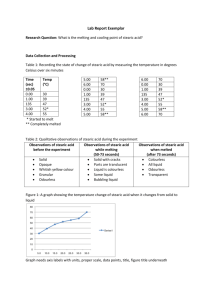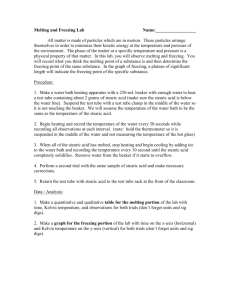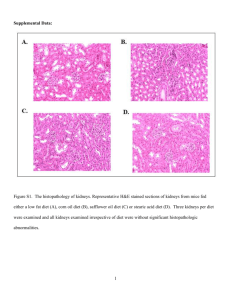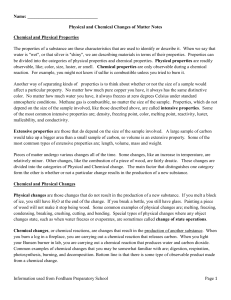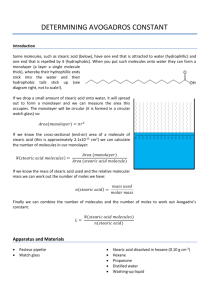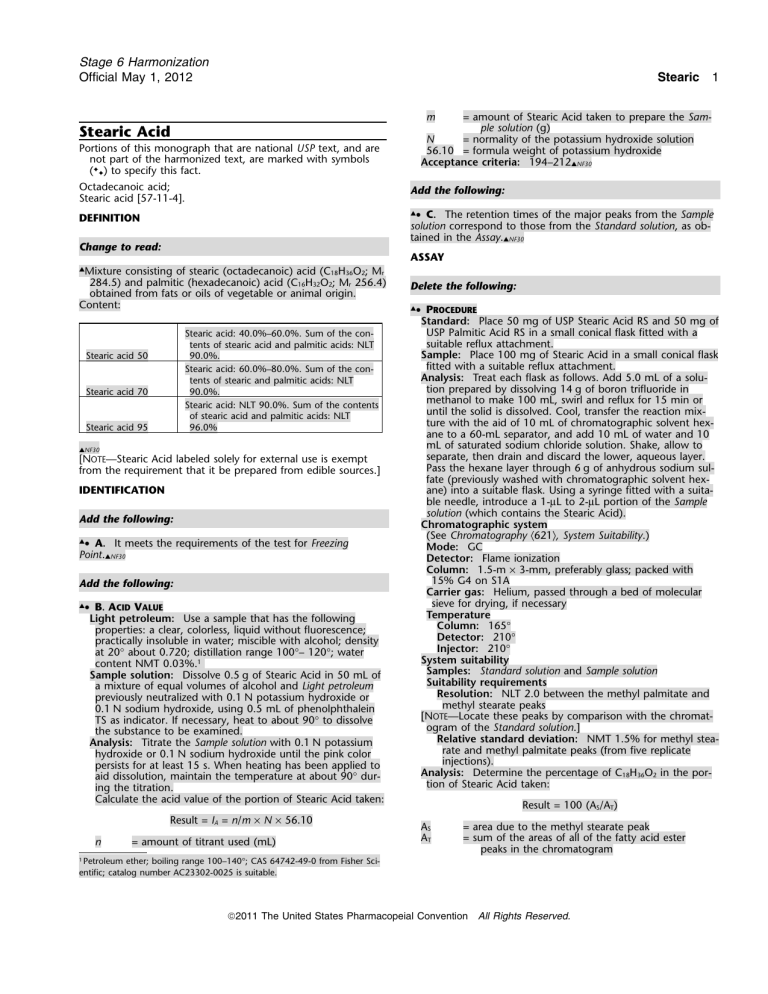
Stage 6 Harmonization
Official May 1, 2012
Stearic 1
m
= amount of Stearic Acid taken to prepare the Sample solution (g)
N
= normality of the potassium hydroxide solution
56.10 = formula weight of potassium hydroxide
Acceptance criteria: 194–212▲NF30
Stearic Acid
.
Portions of this monograph that are national USP text, and are
not part of the harmonized text, are marked with symbols
(✦✦) to specify this fact.
Octadecanoic acid;
Stearic acid [57-11-4].
Add the following:
• C. The retention times of the major peaks from the Sample
solution correspond to those from the Standard solution, as obtained in the Assay.▲NF30
▲
DEFINITION
Change to read:
ASSAY
Mixture consisting of stearic (octadecanoic) acid (C18H36O2; Mr
284.5) and palmitic (hexadecanoic) acid (C16H32O2; Mr 256.4)
obtained from fats or oils of vegetable or animal origin.
Content:
▲
Stearic acid: 40.0%–60.0%. Sum of the contents of stearic acid and palmitic acids: NLT
90.0%.
Stearic acid: 60.0%–80.0%. Sum of the contents of stearic and palmitic acids: NLT
90.0%.
Stearic acid: NLT 90.0%. Sum of the contents
of stearic acid and palmitic acids: NLT
96.0%
Stearic acid 50
Stearic acid 70
Stearic acid 95
▲NF30
[NOTE—Stearic Acid labeled solely for external use is exempt
from the requirement that it be prepared from edible sources.]
IDENTIFICATION
Add the following:
• A. It meets the requirements of the test for Freezing
Point.▲NF30
▲
Add the following:
• B. ACID VALUE
Light petroleum: Use a sample that has the following
properties: a clear, colorless, liquid without fluorescence;
practically insoluble in water; miscible with alcohol; density
at 20° about 0.720; distillation range 100°– 120°; water
content NMT 0.03%.1
Sample solution: Dissolve 0.5 g of Stearic Acid in 50 mL of
a mixture of equal volumes of alcohol and Light petroleum
previously neutralized with 0.1 N potassium hydroxide or
0.1 N sodium hydroxide, using 0.5 mL of phenolphthalein
TS as indicator. If necessary, heat to about 90° to dissolve
the substance to be examined.
Analysis: Titrate the Sample solution with 0.1 N potassium
hydroxide or 0.1 N sodium hydroxide until the pink color
persists for at least 15 s. When heating has been applied to
aid dissolution, maintain the temperature at about 90° during the titration.
Calculate the acid value of the portion of Stearic Acid taken:
▲
Result = IA = n/m × N × 56.10
n
= amount of titrant used (mL)
Delete the following:
• PROCEDURE
Standard: Place 50 mg of USP Stearic Acid RS and 50 mg of
USP Palmitic Acid RS in a small conical flask fitted with a
suitable reflux attachment.
Sample: Place 100 mg of Stearic Acid in a small conical flask
fitted with a suitable reflux attachment.
Analysis: Treat each flask as follows. Add 5.0 mL of a solution prepared by dissolving 14 g of boron trifluoride in
methanol to make 100 mL, swirl and reflux for 15 min or
until the solid is dissolved. Cool, transfer the reaction mixture with the aid of 10 mL of chromatographic solvent hexane to a 60-mL separator, and add 10 mL of water and 10
mL of saturated sodium chloride solution. Shake, allow to
separate, then drain and discard the lower, aqueous layer.
Pass the hexane layer through 6 g of anhydrous sodium sulfate (previously washed with chromatographic solvent hexane) into a suitable flask. Using a syringe fitted with a suitable needle, introduce a 1-µL to 2-µL portion of the Sample
solution (which contains the Stearic Acid).
Chromatographic system
(See Chromatography ⟨621⟩, System Suitability.)
Mode: GC
Detector: Flame ionization
Column: 1.5-m × 3-mm, preferably glass; packed with
15% G4 on S1A
Carrier gas: Helium, passed through a bed of molecular
sieve for drying, if necessary
Temperature
Column: 165°
Detector: 210°
Injector: 210°
System suitability
Samples: Standard solution and Sample solution
Suitability requirements
Resolution: NLT 2.0 between the methyl palmitate and
methyl stearate peaks
[NOTE—Locate these peaks by comparison with the chromatogram of the Standard solution.]
Relative standard deviation: NMT 1.5% for methyl stearate and methyl palmitate peaks (from five replicate
injections).
Analysis: Determine the percentage of C18H36O2 in the portion of Stearic Acid taken:
▲
Result = 100 (AS/AT)
AS
AT
= area due to the methyl stearate peak
= sum of the areas of all of the fatty acid ester
peaks in the chromatogram
Petroleum ether; boiling range 100–140°; CAS 64742-49-0 from Fisher Scientific; catalog number AC23302-0025 is suitable.
1
2011 The United States Pharmacopeial Convention All Rights Reserved.
2
Stage 6 Harmonization
Official May 1, 2012
Stearic
Similarily, determine the percentage of C16H32O2 in the portion of Stearic Acid taken:
AS
AT
= peak area due to methyl stearate
= sum of the peak areas of all the fatty acid esters
in the chromatogram
Similarly, calculate the percentage of palmitic acid
(C16H32O2) in the portion of sample taken:
Result = 100 (AP/AT)
AP
AT
= area due to the methyl palmitate peak
= sum of the areas of all of the fatty acid ester
peaks in the chromatogram
Acceptance criteria: NLT 40.0% of C18H36O2, and the sum
of the two is NLT 90.0%▲NF30
Result = (AP/AT) × 100
AP
AT
= peak area due to methyl palmitate
= sum of the peak areas of all the fatty acid esters
in the chromatogram
Acceptance criteria
For Stearic Acid 50: 40.0–60.0% of C18H36O2, and the sum
of the stearic acid and palmitic acid is NLT 90.0%
For Stearic Acid 70: 60.0–80.0% of C18H36O2, and the sum
of the stearic acid and palmitic acid is NLT 90.0%.
For Stearic Acid 95: NLT 90.0% of C18H36O2, and the sum
of the stearic acid and palmitic acid is NLT 96.0%.▲NF30
Add the following:
• PROCEDURE
Boron trifluoride-methanol solution: 140 g/L of boron
trifluoride in methanol
Standard solution: Prepare as directed under Sample solution using 50 mg of USP Stearic Acid RS and 50 mg of USP
Palmitic Acid RS.
Sample solution: Dissolve 100 mg of Stearic Acid in a small
conical flask fitted with a suitable reflux attachment with 5
mL of Boron trifluoride-methanol solution. Boil under reflux for
10 min. Add 4.0 mL of heptane through the condenser and
boil again under reflux for 10 min. Allow to cool. Add 20
mL of a saturated solution of sodium chloride. Shake, and
allow the layers to separate. Remove about 2 mL of the
organic layer and dry it over 0.2 g of anhydrous sodium
sulfate. Dilute 1.0 mL of this solution with heptane to 10.0
mL.
Chromatographic system
(See Chromatography ⟨621⟩, System Suitability.)
Mode: GC
Detector: Flame ionization
Column: 30-m × 0.32-mm fused silica column coated with
a 0.5-µm layer of stationary phase G16
Temperature
Injector: 220°
Detector: 260°
Column: See Table 1.
▲
IMPURITIES
• ✦RESIDUE ON IGNITION ⟨281⟩: NMT 4 mg, determined on a 4g portion (0.1%)✦
• ✦HEAVY METALS, Method II ⟨231⟩: NMT 10 ppm✦
SPECIFIC TESTS
Delete the following:
• CONGEALING TEMPERATURE ⟨651⟩: NLT 54°▲NF30
▲
Change to read:
• FATS AND FIXED OILS, Iodine Value ⟨401⟩
▲Sample: 1 g
Analysis: Proceed as directed in Method I except to use 15
mL of chloroform.
Acceptance criteria: See Table 2.
Table 2
Type
Stearic acid 50
Stearic acid 70
Stearic acid 95
Table 1
Initial
Temperature
(°)
70
70
Temperature
Ramp
(°/min)
—
5
Final
Temperature
(°)
70
240
Hold Time
at Final
Temperature
(min)
2
5
Carrier gas: Helium, passed through a bed of molecular
sieve for drying, if necessary
Flow rate: 2.4 mL/min
Injection size: 1 µL
System suitability
Sample: Standard solution
Suitability requirements
Resolution: NLT 5.0 between methyl palmitate and
methyl stearate peaks determined on 6 injections
Relative standard deviation: NMT 3.0% for methyl stearate and methyl palmitate peaks (from 6 replicate injections of Sample solution); NMT 1.0% for the ratio of the
peak areas of methyl palmitate to the peak areas of
methyl stearate, from 6 replicate injections
Analysis: Calculate the percentage of stearic acid (C18H36O2)
in the portion of sample taken:
Iodine Value
NMT 4.0
NMT 4.0
NMT 1.5
▲NF30
Delete the following:
• MINERAL ACID: Shake 5 g of melted Stearic Acid with an
equal volume of hot water for 2 min, cool, and filter: the filtrate
is not reddened by the addition of 1 drop of methyl orange
TS.▲NF30
▲
Delete the following:
• NEUTRAL FAT OR PARAFFIN
Sample solution: 1 g of Stearic Acid in 30 mL anhydrous
sodium carbonate solution (1 in 60)
Analysis: Boil the Sample solution.
Acceptance criteria: The resulting solution, while hot,
shows NMT a faint opalescence.▲NF30
▲
Result = (AS/AT) × 100
2011 The United States Pharmacopeial Convention All Rights Reserved.
Stage 6 Harmonization
Official May 1, 2012
Stearic 3
Add the following:
• COLOR OF SOLUTION
Standard stock solution Y (yellow): 2.4 mL of ferric chloride CS, 0.6 mL of cobaltous chloride CS, and 7.0 mL of
hydrochloric acid solution (10 g/L)
Standard stock solution BY (brownish-yellow): 2.4 mL of
ferric chloride CS, 1.0 mL of cobaltous chloride CS, 0.4 mL
of cupric sulfate CS, and 6.2 mL of hydrochloric acid solution (10 g/L)
Standard solution Y: 2.5 mL of Standard stock solution Y
and 97.5 mL of hydrochloric acid solution (10 g/L)
Standard solution BY: 2.5 mL of Standard stock solution BY
and 97.5 mL of hydrochloric acid solution (10 g/L)
Analysis: Heat Stearic Acid to 75°.
Acceptance criteria: The resulting liquid is not more intensely colored than Standard solution Y or Standard solution
BY.▲NF30
▲
1-L beaker containing a suitable cooling liquid to within 20
mm of the top. A thermometer is supported in the cooling
bath. Place in the inner tube sufficient quantity of the liquid
or previously melted substance to be examined, to cover the
thermometer bulb, and determine the approximate freezing
point by cooling rapidly.
Analysis: Place the inner tube in a bath about 5° above the
approximate freezing point until all but the last traces of
crystals are melted. Fill the beaker with water or a saturated
solution of sodium chloride, at a temperature about 5°
lower than the expected freezing point, insert the inner tube
into the outer tube, ensuring that some seed crystals are
present, and stir thoroughly until solidification takes place.
Note the highest temperature observed during solidification.
Acceptance criteria: See Table 3.
Table 3
Type
Stearic acid 50
Stearic acid 70
Stearic acid 95
Add the following:
• ACIDITY
Analysis: Melt 5.0 g of Stearic Acid, shake for 2 min with 10
mL of hot carbon dioxide-free water, cool slowly, and filter.
To the filtrate add 0.05 of methyl orange TS.
Acceptance criteria: No red color develops.▲NF30
▲
Add the following:
Freezing Point (°)
53–59
57–64
64–69
▲NF30
ADDITIONAL REQUIREMENTS
• ✦PACKAGING AND STORAGE: Preserve in well-closed
containers.✦
Change to read:
• FREEZING POINT
Apparatus: Consists of a test tube about 25 mm in diameter
and 150 mm long placed inside a test tube about 40 mm in
diameter and 160 mm long. The inner tube is closed by a
stopper which carries a thermometer about 175 mm long
and graduated in 0.2°, fixed so that the bulb is about 15
mm above the bottom of the tube. The stopper has a hole
allowing the passage of the stem of a stirrer made from a
glass rod or other suitable material formed at one end into a
loop of about 18 mm overall diameter at right angles to the
rod. The inner tube with its jacket is supported centrally in a
▲
• LABELING: If it is for external use only, the labeling so indicates. ▲The label states the type of stearic acid (50, 70, or
95).▲NF30
• USP REFERENCE STANDARDS ⟨11⟩
USP Palmitic Acid RS
USP Stearic Acid RS
2011 The United States Pharmacopeial Convention All Rights Reserved.

